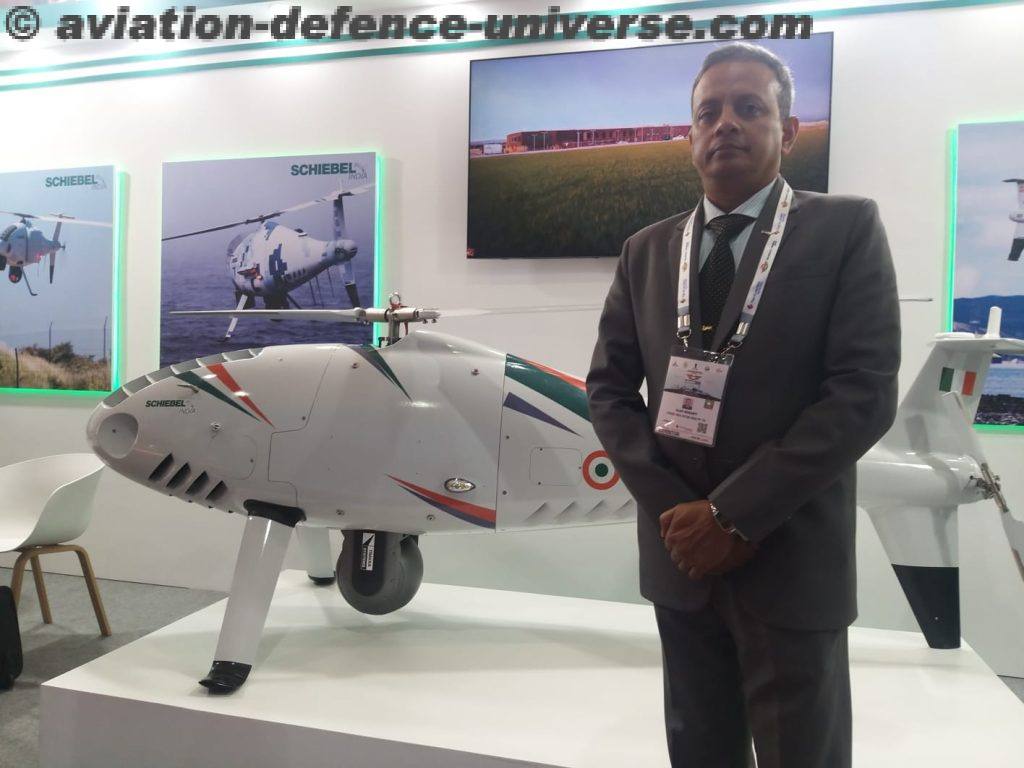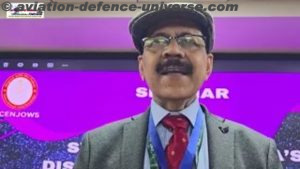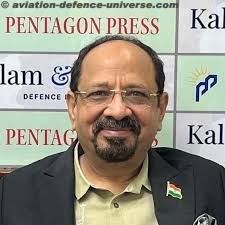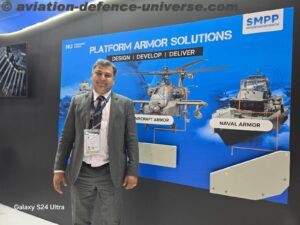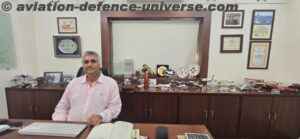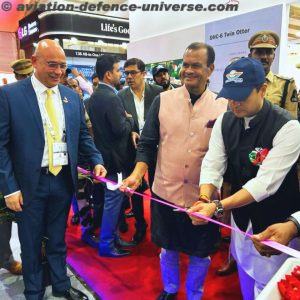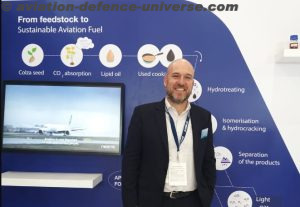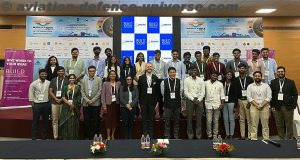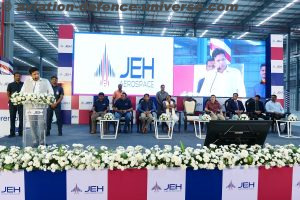By Sangeeta Saxena
Begumpet, Hyderabad. 23 January 2024. “For both military and commercial use, Schiebel’s CAMCOPTER® S-100 Unmanned Air System (UAS) has a track record of success. There is no need for a launch or recovery pad or prepared area when using the Vertical Takeoff and Landing (VTOL) Unmanned Aerial System. It can operate on land and at sea for up to 200 kilometres, day or night, and in inclement weather. The S-100 can be controlled directly with a pilot control unit or it can navigate automatically using GPS waypoints that have been pre-programmed. Using a straightforward point-and-click graphical user interface, missions can be planned and managed. Real-time high-definition payload imagery is sent to the control station. Even in the most complicated electromagnetic environments, the UAV can autonomously accomplish its mission thanks to “fly-by-wire” technology managed by redundant flight computers. Its titanium and carbon fibre fuselage allows it to carry a large variety of payload and endurance combinations,” stated Jajati Mohanty, CEO Shiebel System India in an exclusive conversation with Sangeeta Saxena, Editor, Aviation & Defence Universe (ADU) at the recently concluded airshow Wings India 2024.
ADU. We are here at Wings India and Schiebel is here for the first time. What market do you expect out of this show?
JM. What I would like to say is that Schiebel has been a market leader in the rotary UAV for almost 18 years now. And we are well known among the military and government. The same thing holds good for the Indian armed forces also. We are now in a position where we are delivering to the Indian Navy. However, we realise that India has got huge potential in terms of the oil and gas, the pipelines, the railways, the transmission lines also. And it doesn’t run in hundreds of kilometres, it runs in tens and thousands of kilometres. And all of them require monitoring. So, we realized that there is a huge market available in India.
ADU. Then why a civilian show why not Aero India?
JM. So, we wanted to check out the market. So, testing of new waters can only happen in places like Wings India where you have civilian customers coming in. So, we decided that this year let’s participate here in Wings India and get a feel of the customer base which is here. Because irrespective of what we sell around the world, we have around 40 countries where we have sold our products and it’s a combination of military as well as the civilian customers. So, we planned the same thing in Wings India. What is important is that our product is a dual use product.
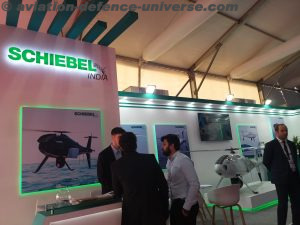 ADU. Camcopter is Schiebel’s most popular product and we see it at all shows globally. How can it be a perfect fit for Indian security arena?
ADU. Camcopter is Schiebel’s most popular product and we see it at all shows globally. How can it be a perfect fit for Indian security arena?
JM. It is cleared for operation in the military domain. And it is also authorized through the ESA, that is the European Aviation Safety Agency for being operated in the private domain or the civilian domain. So, from that point of view, it becomes easier for us to get a Type C certification which happens in India for a licensed flight. And another thing which is good about the Camcopter is though it is a UAV, it is made as per manned aviation standards. So, that means when we fly it, it looks as if it is a manned aviation flight. That makes it difficult to be recognised as a drone and therefore it becomes easier to fly without getting detected. That means the ATCs don’t have a problem. They know exactly a bird is flying at this height and providing all the necessary information.
ADU. Is it certified by DGCA?
JM. No, we are planning to apply for it. It will not be a very long activity because we are already certified by ESA. And the plan was to first taste the water of the appetite of the market here, then plan out.
ADU. And how did you find that?
JM. We were really surprised that on the first day itself there were overwhelming inputs coming for people to buy. So, then we have now taken a call that yes, we will commence with the activities of the certification to fly, license to fly in India. And then we will take it from there. Because there are people who are already waiting, who want to place order on us now itself.
ADU. Can you tell us more about the Indian Navy’s demand?
JM. Schiebel came to India in 2006. It’s a long time back. We did our first trials with the Indian Navy and it was in the Southern Naval Command at Kochi. However, at that time the armed forces did not have a very standard procurement manual. The DPP in 2006 came pretty late in 2007. And by that time the trials were over and things got lost out here and there. And though Schiebel tried to get a good agent here to understand the market, but nobody had a strong foot on the ground. So since this scenario, Schiebel became busy all around the world and India took a little bit of a back seat. Now with them playing a major role in Europe, US, Asia and Middle East, they realized that time has come when re-entry into India could be done. So, that’s how the meetings and the discussions started in 2018 onwards. And one thing led to the other. We have our production partner, VEM Technologies. And with them, we are doing the manufacturing setup and everything.
ADU. Does VEM Technologies match steps with your technology?
JM. So, we did not have an issue of technology because VEM was already into a lot of high-end stuff. So, therefore, it was very easy. And that’s the reason why our first batch when we did the assembly and integration happened so fast. Because even the DBAQ, the team was here. They were also surprised that not only the OEM, but the person who was the production partner also knows about everything. And things went on very fast. And we finished the flight trials here in Hyderabad itself.
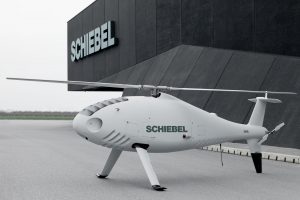 ADU. What about the supply chain for the Camcopter in India?
ADU. What about the supply chain for the Camcopter in India?
JM. I can say very reasonably that we are slowly setting up a distributor network. Because like all OEMs of UAVs, there are only a few things we make. The remaining thing is all outsourced from around the world. Because it has no meaning to buy everything. So, our distributor network has been set up in India so that we will be able to procure the items. These are all bought out. So, anybody can buy it anytime. And the engine, the gearbox, which is an IP for us, continues to come from Austria. The software licensing has already happened for India. That means we have the licenses available here. We can modify, we can upgrade, we can recondition whatever is there in India.
ADU. How do you envisage the MRO activities for the Camcopter in India?
JM. There is no requirement for any part to go back outside. It will all happen in India. The MRO has been set up in such a manner that everything happens in India itself. And we will be self-sustaining because Navy was very particular that the Camcopter is here to stay. They would like to use it for a long time. Therefore, the MRO activities and all other activities are also kept within the country.
ADU. What is the numbers the Navy has procured?
JM. I will not be able to share the numbers. But it is a substantial number, which is the initial lot. And thereafter, as and when the ships keep on coming in, we will have the re-orders.
ADU. And for the commercial market, like you are here in a civilian show. So, what is the sort of response you have got? Have you got them from which areas?
JM. Actually, you will find that here also it is those areas where you generally have a little bit of deep pockets. So, it is the paramilitary which has indicated certain amount of interest and those areas we are looking at very strongly. Oil and gas is a major area we are looking at. Because the cost of operations, particularly the operational cost, may come down drastically for offshore operations. With the help of this kind of a UAV, it can be used for logistics, stack monitoring, general regular monitoring, SAR operations.
ADU. So, did you get these people from the public sector units like ONGC and Oil and Oil?
JM. ONGC is actually doing more than just coming here to have a look at the show birds. They have indicated that they would like to participate in the demo. In fact, we are doing flight trials for the Navy. So, we plan to show the demo to ONGC during that time. That will provide them with a very clear picture of the capability of the birds, how it happens. And then of course, once it happens, by then we would have already planned out for our DGCA certification and all the regulatory activities. And things will fall into place. The other areas, other ministries which have shown a lot of interest are the power industry for monitoring of the transmission lines. The railway industry for the monitoring of railway tracks. Because presently, in fact we had a pretty good meeting recently. I will not name but the contract which is there with them right now for doing the monitoring of the railway line is for two-year for a certain stretch of railway line. And they can finish that in two to three months. So, that’s the kind of capability which this kind of a product provides to the civilian industry also. The same thing holds good for your super expressways. Because now you have got roads being made in a fantastic manner. So, they require monitoring, they require survey too. This provides a fantastic opportunity for road transport also to monitor the super highways which are there.
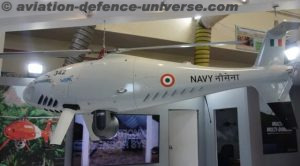 ADU. What do you expect once you are off from this show? How much do you think will fructify?
ADU. What do you expect once you are off from this show? How much do you think will fructify?
JM. We are expecting that at least out of the 100% enquiries which have come, we are expecting at least 45-50% will fructify into orders.
ADU. As final assembly line is in Austria and all the supply chain?
JM. Assembly line is in India, in Hyderabad. Everything comes as parts from the suppliers and some from Austria, whereas we are integrating everything in India. So, your final assembly line is here in Hyderabad. The assembly line and the intermediate line will be with VEM Technologies. They are our production partners. Most of the critical technologies are already existing with VEM. And that’s one of the reasons why so many foreign companies come to them for manufacturing.
ADU. And what generally could be the sort of numbers they would make in a month for you?
JM. The numbers all depend on the customers. Yeah. So, therefore, we can make up to 30-35 in a year. That’s generally a pretty good number for every year. There is a kind of market which is there around the world. That is very much doable. Because the best part is the manufacturing. We are sourcing a lot of things. It’s only the engine and the gearbox which is coming from outside. That’s it.
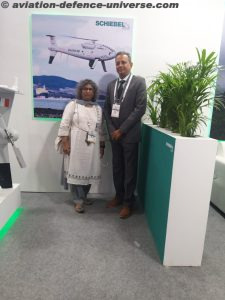
ADU. So, you have your supply chain in India also?
JM. We have made and distributed a network which is very nascent right now. But we will slowly, slowly expand it to directly deal. Like for example, we buy a lot of stuff from Honeywell . I don’t need to buy it from Europe or US. Honeywell has a setup very much in India. So, that’s how we will set up slowly to grow our supply chain. It’s not possible to do it in one year. It’s just a question of distribution now. It’s a process.
ADU. Anything you would like to add from your side?
JM. We are very happy to have customers in India. Because India is a very, very strong and important UAV market. And the nature is so varied in India. So, you need UAVs to ensure that things are happening in the right time. And the GAM COP 200 is a very, very suitably placed UAV. As of right now, we don’t see any kind of competition.
Schiebel Inda intends to deliver a proven tactical maritime ISR capability at sea under the Naval Ship-borne Unmanned Aerial System (NSUAS) Fast Track Programme, opening a new chapter in tactical exploitation and maritime capability enhancement for the Indian Navy.
The company intends to work in tandem with the Indian Army to provide operational logistics support, as well as the Indian Coastguard for ISR and SAR operations.
As told to Sangeeta Saxena






































